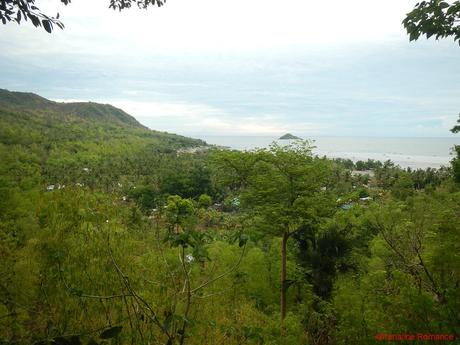
The Philippines is a large tropical archipelago of 7,107 beautiful islands. So many yet so interestingly different from each other. With their own unique historical, cultural, and natural characteristics, traveling around our country is never boring. For us, it’s always a new experience in each island destination. And in Gigantes Norte in Islas de Gigantes, Iloilo, we were able to visit two of its own wonders that makes it unique.
We welcomed a cold morning at 5AM and got ready for our next adventure. Edcel together with his team of habal-habal drivers and co-guides fetched us at the resort. From there, we headed for the morning’s first destination.
The road network around Gigantes Note and presumably Gigantes Sur is far from being developed. Yes, there are cemented sections, but there are also a lot of potholes and cracks. In many areas, the roads are left unpaved and bumpy.
Hopefully, the local tourism office and the Department of Public Waterworks and Highways (DPWH) will jointly address this issue not just to make tourist attractions accessible but also to enhance convenience and spur economic development for the locals.
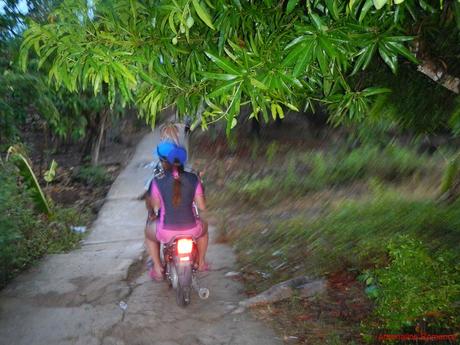
Old Parola
After a 20-minute ride, we arrived at the 18th century lighthouse, or parola, of Gigantes Norte. Located in Sitio Parola, Barangay Granada, this is one of the most popular attractions in the island and is a must-visit place.
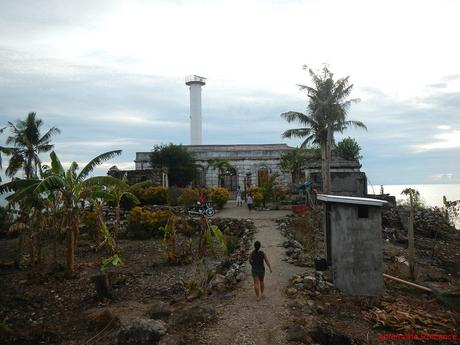
According to Edcel, government officials initially planned to have the derelict facility demolished to give way to a new, modern lighthouse. However, they recognized the historical and cultural significance of the structure as well as its potential for tourism.
With the help of partners and donors of the ABS-CBN Lingkod Kapamilya Foundation, Inc, restoration efforts recently began in April 2016. Restorers and workers are careful to preserve the original look of the facility.
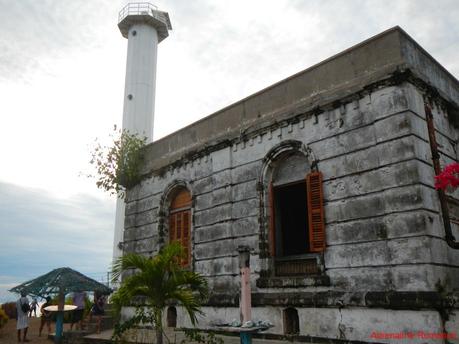
Here’s a look at the interior of the parola. As you can see, the old plaster, hardwood floors, wooden beams, and Spanish-style windows are still retained.
Plans include conversion of one room into a cafe, another room into a museum, and another one into a historical-cultural office.
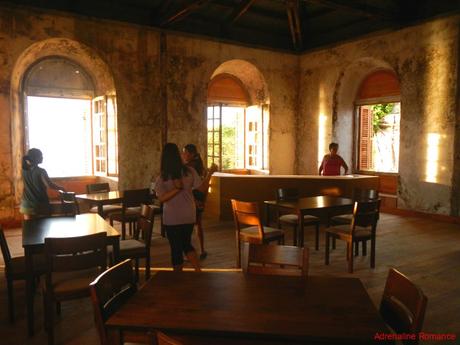
These are the old optical lenses that were once used when the lighthouse still featured the old Fresnel light system. With the advancement of lighthouse technology, however, the Fresnel lenses were discarded for their obsolescence.
The parola’s museum still has scant collections; but they do have on display an old clock, old journals of lighthouse keepers, and a few ancient office equipment.
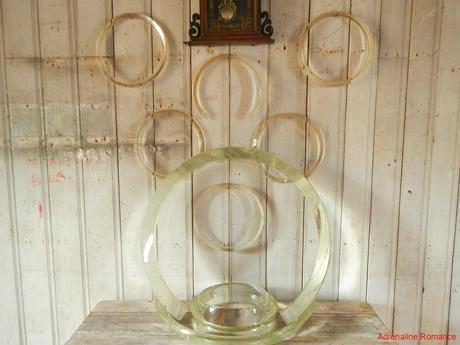
A new steel-tower lighthouse is erected just outside the old parola. It is less picturesque, of course, but it serves its purpose. Like many modern lighthouses, it is unmanned and uses solar power to activate a flashing light at the top.

Where there is a lighthouse, there is a view deck which opens up to encompassing vistas of mystical seascapes. We silently reveled in watching the sun wake up from her underwater slumber while reflecting on beautiful friendships, amazing adventures, and gentle love.

After touring the parola, it was time to head off to our second destination. But first, we stopped by this makeshift souvenir “stall” run by local kids. These small entrepreneurs are absolutely creative. They even scripted their own greetings, jingles, and sales pitches to impress customers to buy their wares! Wow!
And impressive there wares truly are! These decorations, jewelry, and paperweights are entirely made by hand using washed-up shells, wires, and other everyday items.

Bakwitan Cave
After a 30-minute ride, we reached the jumpoff point in Bakwitan Cave, another popular destination in Islas de Gigantes. Sweetie, Halourd, and I were itching for some adventure, and at last, we’ll be getting one.
Now before anything else, let me remind our readers that Bakwitan Cave is a show cave. That means, it is often visited by tourists. Also, true caving is a very tiny, negligible blip in the tourism industry in Islas de Gigantes. Thus, the LGU has not purchased helmets, headlamps, overalls, and other equipment that are used in exploring caves.
Had we known we were entering a cave, we would have bought our own helmets, flashlights, and proper apparel. We didn’t know this so we entered Bakwitan Cave wearing T-shirts and shorts. Em-em was even wearing a tube tank top! Hehehe! But Edcel assured us that it is safe, so off we went.

The first part was to trek up this stony trail. Don’t worry, the ascent is gradual and easy, and it will take guests only 15 minutes to reach the mouth of the cave. We just needed to watch out for sharp rocks and loose soil since we were just wearing slippers and not trekking sandals or shoes.

The large entrance to Bakwitan Cave clings to the side of a cliff. We had a short rest before proceeding inside. Note the rock formations which are “dead” after eons of exposure and human touch.
Check out our caving “attire.” Hehehe!
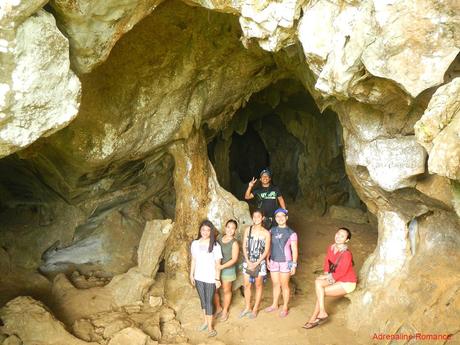
Just right beside the entrance is this natural alcove. What’s so special about this little nook? Well, see those things that form an X? Those are actually human femurs—bones! According to Edcel, Bakwitan cave was once a sacred burial ground for their ancestors. But treasure hunters of the past have desecrated the cave and took human remains, pottery, and other relics away from their resting place.
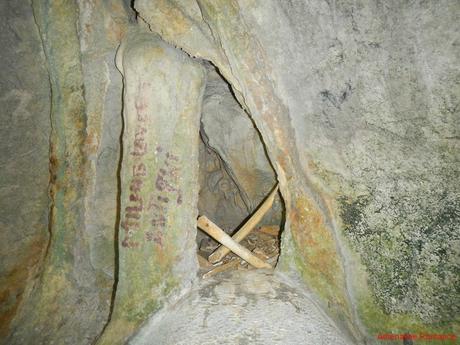
Armed with nothing but household flashlights, the guides led us inside the heart of the karst formation.
There’s another legend about the etymology of Islas de Gigantes which involves Bakwitan Cave. Lit by dim candlelights, locals tell tales of early explorers who found gigantic sets of human bones inside Bakwitan Cave. It is for this reason that the locals decided to rename the islands as Islas de Gigantes. They believed it was populated by mythical giants.
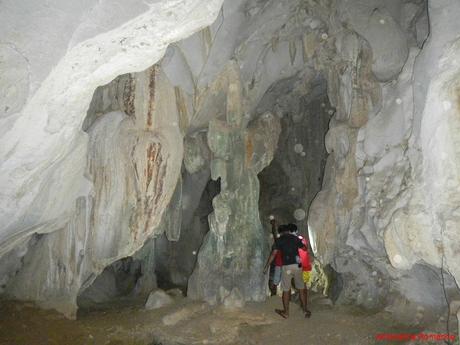
The guides pointed to us various beautiful rock formations and flowstones. These formations are now dead (i.e., the absence of moisture or mineral deposits associated with moisture), but they will retain their interesting forms for eternity because erosion is virtually negligible in a dry cave system. That is why drawing or scratching graffiti inside a cave is a no-no; the lack of erosion will actually preserve the remnants of human activity.
Unless, of course, if it is disturbed by human hands.
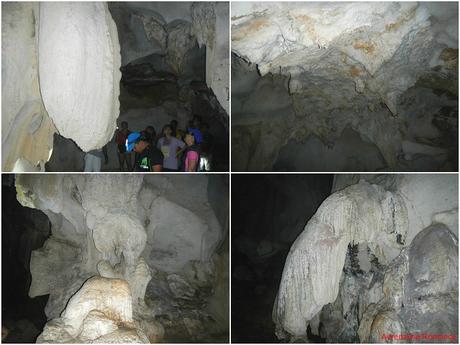
But while some parts of the cave are dead, many are also “alive.” Indeed, we found these young, glittering flowstones that are wholly pristine and perfectly preserved.
Don’t touch these speleothems else the acid from your hand will cause the crystals to wither and die.
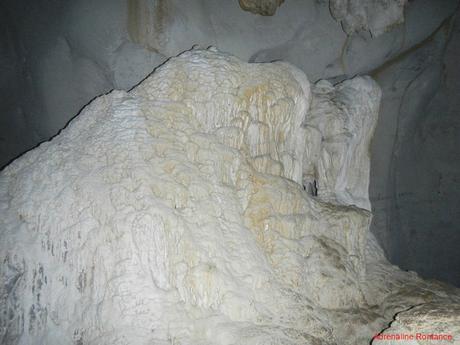
Angels in the cave! A hole in the cave’s ceiling illuminates the interior. Sadly, our camera’s limited capability can’t capture that heavenly light that you usually see in cave photos.
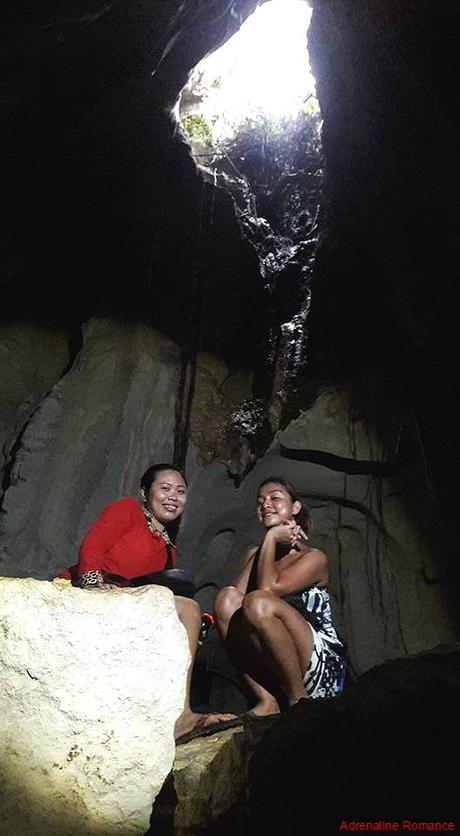
(Photo credit: Line Tubog)
Deeper into the cave, the passages became bigger. The ceiling, which was just several feet above our heads as we entered, soared to incredible heights. At times, the ceiling was barely visible.
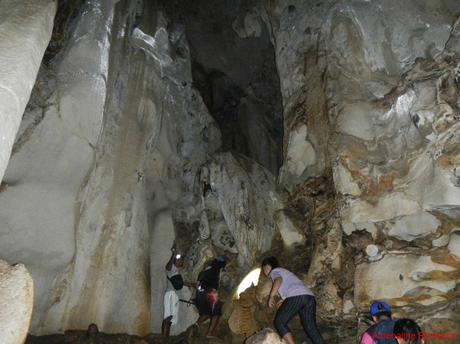
That might look like snot or slime, but that is actually a speleothem in the making. Water that is saturated with calcium carbonate deposits drips from the ceiling. In time, perhaps in a thousand or million years, the accumulation of calcium deposits forms a lovely, sparkling stalagmite.
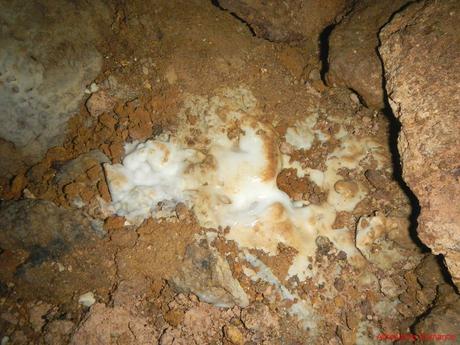
Check out this massive column! It is formed when the tip of a stalactite meets the point of a stalagmite directly below it. Over time, the accumulation of sediments thickens the once-conical meeting point, making it look like a cylinder.

In the middle of the Bakwitan Cave, Edcel halted the group. He explained that normally, this is where the tour usually ends. However, if we want to, we could continue albeit at our own risk. That’s because it would involve crawling under tunnels and climbing over near-vertical rock formations.
After his 5-minute warning spiel and asking if we want to go back or if we want to continue adventuring, the group unanimously exclaimed, “Go adventure!” Nobody’s stopping! It started with a really low crawl.
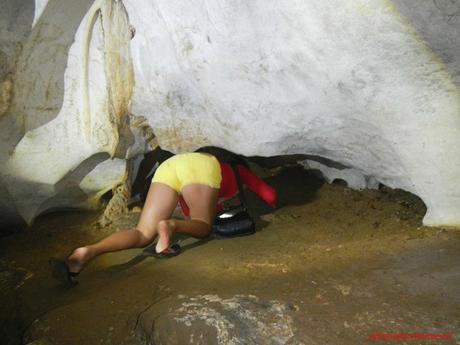
Because this place is not frequently visited, most of the rock formations remain untouched. They still retain their form, and some even had films and drops of moisture.
Check out the slab at the right. Can you see the sparkling gypsum crystals?
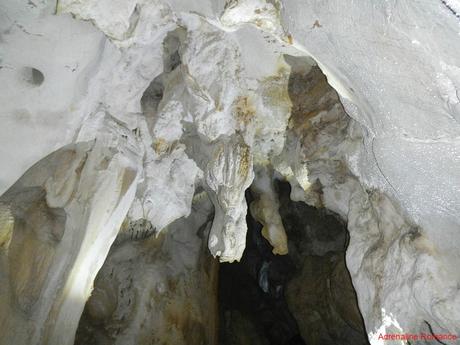
We arrived at the first vertical ascent. Edcel showed us how to climb the slippery rock safely. Alexa was terrified at the idea of climbing a tall, slimy rock without safety equipment, and the poor girl wept. But after encouraging her that she can do it (and by telling her to imagine that her crush was up there waiting for her), she was able to ascend this tricky part.
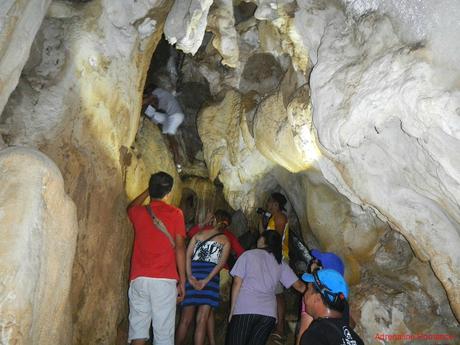
The second vertical ascent was even trickier and potentially more dangerous. That’s because in the photo below, just behind Edcel, is a large hole that is about 20 to 30 feet deep. You don’t want to fall that far!
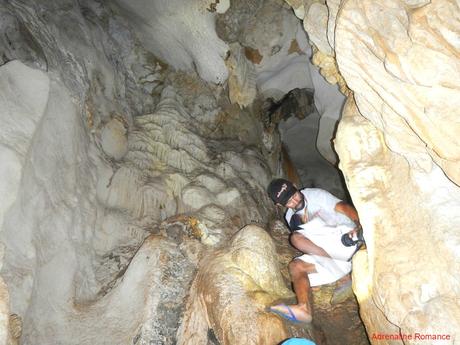
After climbing that section, it was an 80-degree, four-by-four ascent (you use your hands and legs) to reach the exit. We had to crawl low because we don’t have helmets. We don’t want to hit our heads on hard rock or the occasional delicate stalactite.

At last, after an hour in a world of rocks, tunnels, and darkness, we finally saw the glorious light of day. We were almost out of Bakwitan Cave!
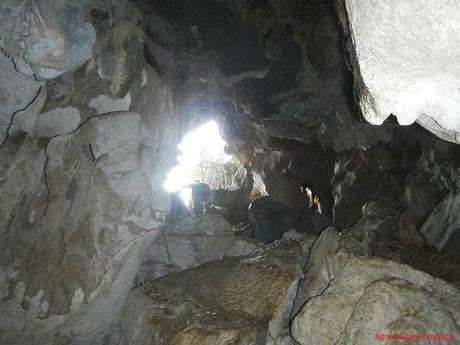
That’s the exit of the cave. The rocks are still largely untouched.
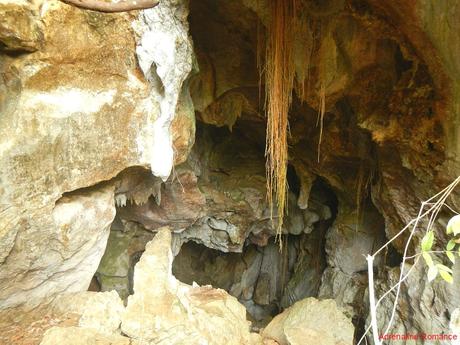
Because the exit is on top of a huge karst formation, we were able to see an encompassing view of the northern side of the island’s coast. Now that’s a truly lush place, don’t you think?
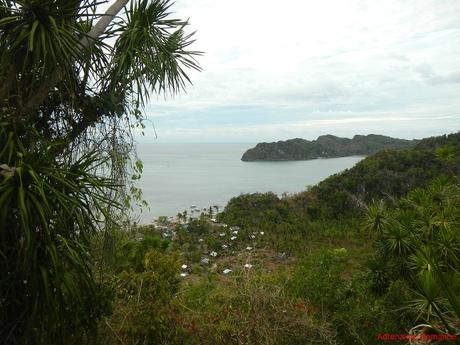
Just because we were out of the cave meant that our challenge was over. Descending the karst mountain was the next stage of our adventure. We had to slowly and carefully go down over huge razor-sharp rocks. This was more difficult than it sounds because we were just wearing flimsy slippers and were unequipped with gloves.

Just check out how steep the trail is. But in the midst of pain and danger, we had a whole lot of fun.
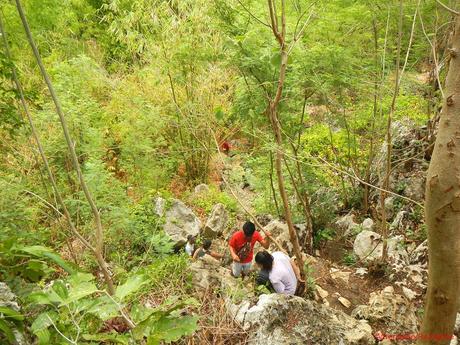
Finally, we were back at our starting point. Congratulations, we made it! Great job, guys and girls!
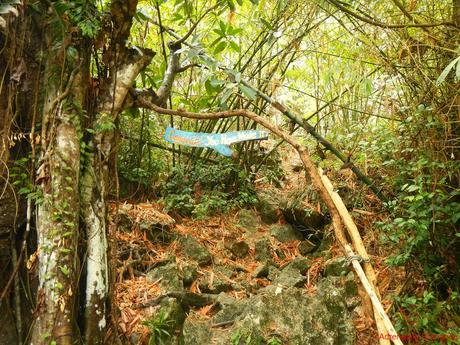
We went back to our resort to have a quick breakfast and a shower. After packing up and making sure nothing left, we rode habal-habals back to the dock where our pumpboat was waiting.
Check it out; even if this is a common dock, the beach is still very clean. In fact, when we arrived, there were a couple of kids who enjoyed a mid-morning swim in the clear water.
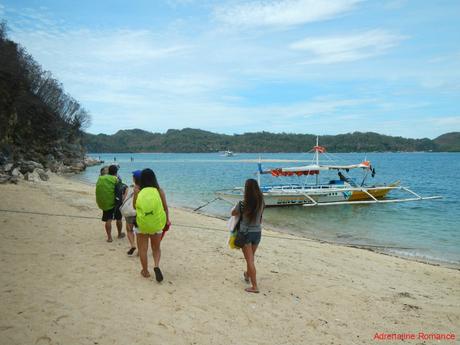
Farewell, Islas de Gigantes! Thank you for letting us visit your sandy paradises, secret pools, colorful reefs, and mysterious caves. Thank you for allowing us to enjoy your bounty.
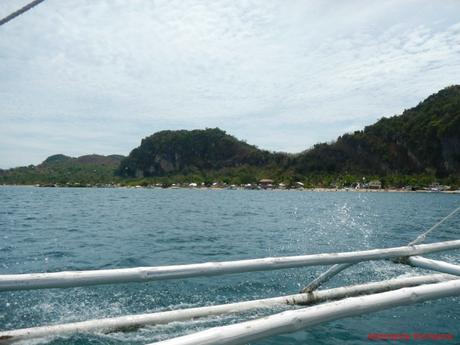
We made our way back to Iloilo so we could catch our ship back home. When we arrived in Cebu the following day, it was raining cats and dogs! We were definitely lucky; we enjoyed Islas de Gigantes in two days of sunny weather!
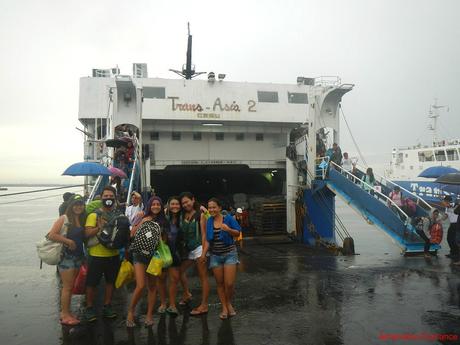
Special Thanks
We would like to give our heartfelt thanks to Sir Edcel Arnado. From start to finish, he was there with us. He took care of our permits, boat transfers, accommodation, and more. Hell, we believe he even had a hand in cooking all our delicious meals! Thank you, sir, for being an exceptional guide.
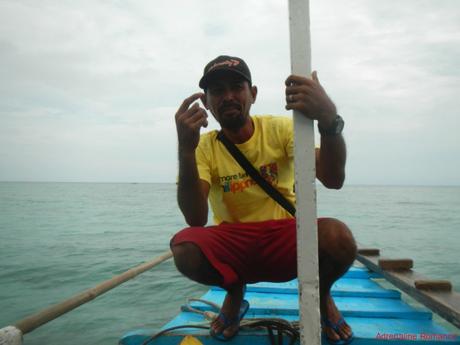
Life is a reward. And our summer escapade in Islas de Gigantes is one amazing, well-deserved reward. We know there are still a whole lot of wonders to discover in this idyllic island chain. Now, that would be another reward for next year!
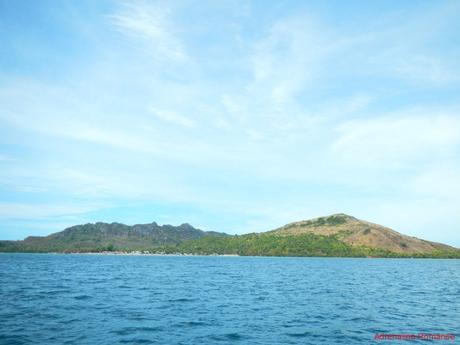
Itinerary
Day 4
5:00 AM – wake up, pack up
5:30 AM – pick up at resort, habal-habal ride to Old Parola
6:00 AM – arrival at Parola, picture taking
6:00 AM – leave Parola, habal-habal ride to Bakwitan Cave
7:30 AM – arrival at Bakwitan Cave, start caving adventure
8:30 AM – exit Bakwitan Cave, start descent
9:00 AM – arrival at exit, habal-habal ride to resort
9:20 AM – arrival at resort, breakfast, shower
10:30 AM – check out, leave resort, habal-habal ride to beach dock
11:00 AM – depart Islas de Gigantes, boat ride to Estancia
12:00 NN – arrival at Estancia, lunch
1:00 PM – bus ride from Estancia to Tagbak Bus Terminal, Iloilo City
4:00 PM – arrival at Iloilo City, ride jeepneys to port
5:00 PM – arrival at port, buy dinner, snacks, and souvenirs
7:00 PM – depart Iloilo, head to Cebu
Budget*
- P 200 per person – inland tour including habal-habal ride from and back to the resort.
- P 500 per group – caving guide fee. Because of their excellent service, we gave a tip of P100 for each of our 3 guides.
- Any amount – Bakwitan cave donation
- P 20 per person – habal-habal ride from resort to dock
- P 15 per person – tricycle fare from Estancia Port to Estancia Bus Terminal
- P 150 per person – air-condtioned bus fare from Estancia to Tagbak Bus Terminal
- P 7 per person – jeepney fare, Tagbak Bus Terminal to Iloilo Town Center
- P 7 per person – jeepney fare, Iloilo town center to Iloilo Port
- P 860 per person – Trans Asia boat fare from Iloilo to Cebu
The return trip from Islas de Gigantes to Estancia is already covered in our boat rate. Please check the Budget section of our previous post.
* We did not include our expenses for meals, snacks, souvenirs, tips, and other fees in this rate sheet as you may have different needs, preferences, itineraries, miscellaneous transportation, and sharing scheme from us. Note that all figures are subject to change without prior notice.
Tips to follow

